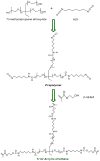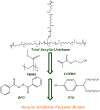Synthesis of a Room-Temperature Curable Acrylic-Urethane Polymer Binder for Road Markings with High Transmittance
- PMID: 36770328
- PMCID: PMC9920224
- DOI: 10.3390/ma16031322
Synthesis of a Room-Temperature Curable Acrylic-Urethane Polymer Binder for Road Markings with High Transmittance
Abstract
Triol acrylic-urethane (t-AU) was synthesized from an addition reaction using trimethylolpropane, hexamethylene diisocyanate, and 2-hydroxyethyl methacrylate. The novel acrylic-urethane polymer was applied to a high-performance binder to prepare a reliable road marking paint. Acrylic-urethane polymer binder formulations were designed to optimize the effect of t-AU on the physical properties. The t-AU content in the formulation affected the adhesion and optical properties. The improvement in the adhesive performance and transparency ability for road markings was attributed to the optimal chemical structure or design of the acrylic-urethane polymer. The synthesis of t-AU was confirmed by Fourier transform infrared spectroscopy, and molecular weight and polydispersity index (PDI; PDI = Mw/Mn) measurements. The tensile and shear strength, hardness, gel fraction, crosslink density, contact angle, and transmittance of the acrylic-urethane polymer binder (AUP) were evaluated by curing at room temperature using a redox initiator system. An optimized AUP by adding 5 wt.% t-AU provides a viable alternative to high-performance binders in road marking paints.
Keywords: acrylic-urethane binder; redox initiator system; road marking paint; room temperature curing.
Conflict of interest statement
The authors declare no conflict of interest.
Figures








References
-
- Dormidontova T.V., Filatova A.V. Research of influence of quality of materials on a road marking of highways. Procedia Eng. 2016;153:933–937. doi: 10.1016/j.proeng.2016.08.256. - DOI
-
- Nance J., Sparks T.D. From streetlights to phosphors: A review on the visibility of roadway markings. Prog. Org. Coat. 2020;148:105749. doi: 10.1016/j.porgcoat.2020.105749. - DOI
-
- Babic D., Burghardt T.E., Babic D. Application and Characteristics of Waterborne Road Marking Paint. Int. J. Traffic Transp. Eng. 2015;5:150–169. doi: 10.7708/ijtte.2015.5(2).06. - DOI
-
- Burghardt T.E., Pashkevich A., Zakowska L. Influence of volatile organic compounds emissions from road marking paints on ground-level ozone formation: Case study of Krakow, Poland. Transp. Res. Procedia. 2016;14:714–723. doi: 10.1016/j.trpro.2016.05.338. - DOI
LinkOut - more resources
Full Text Sources

